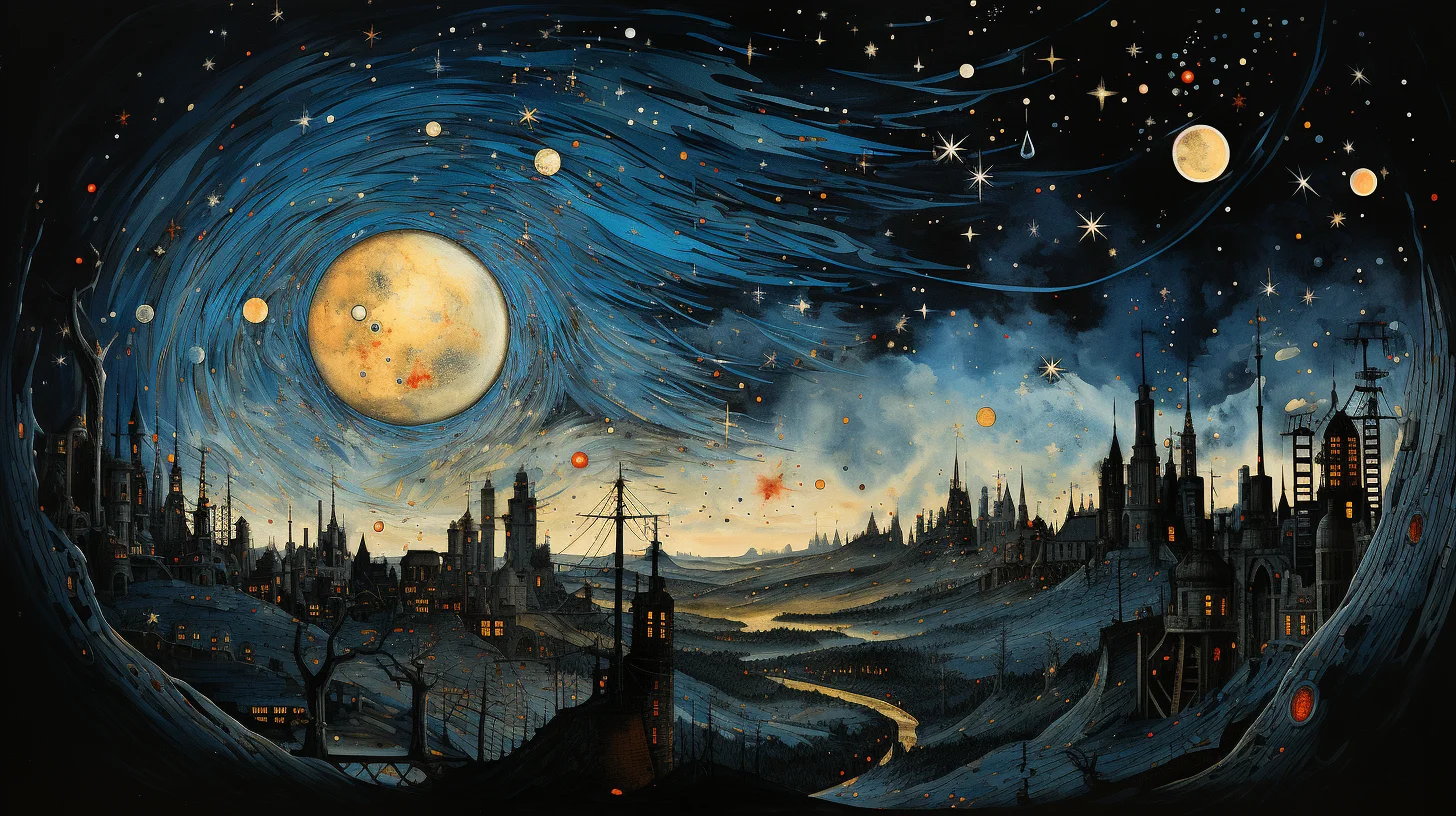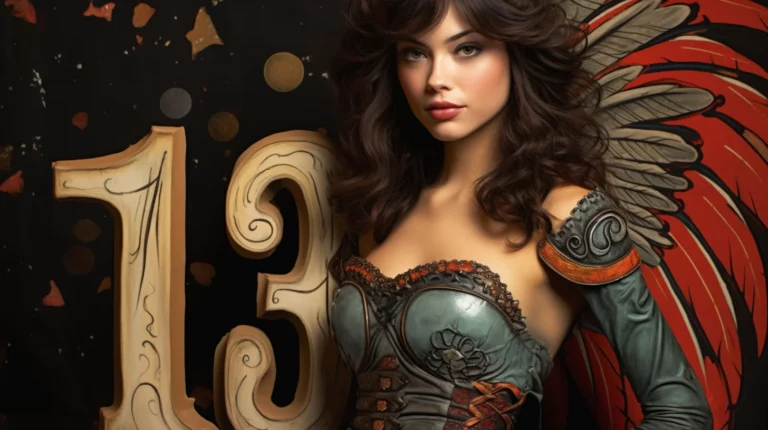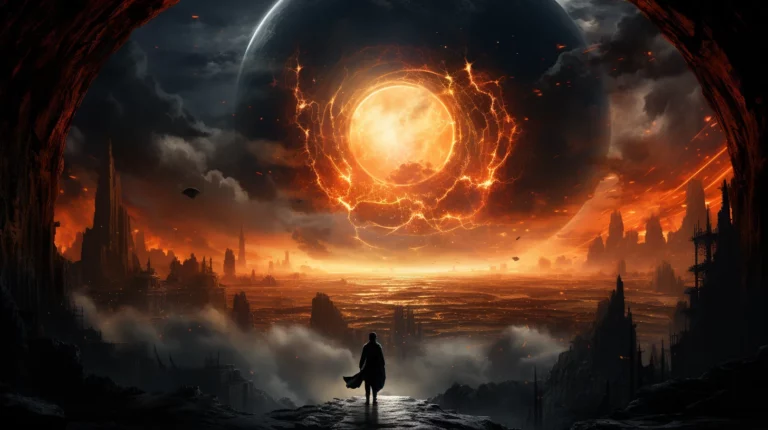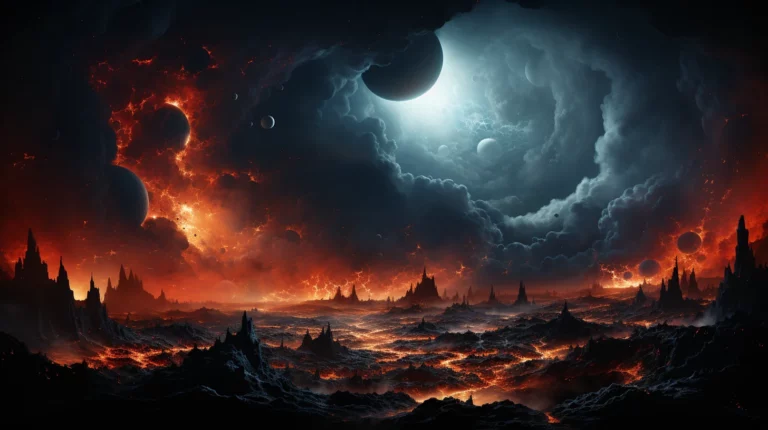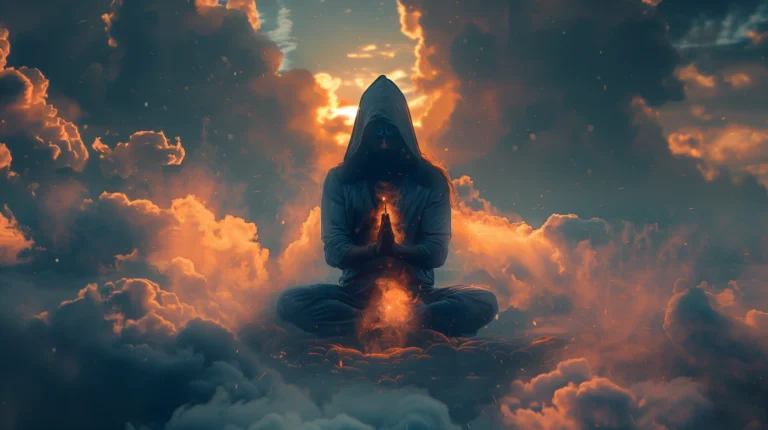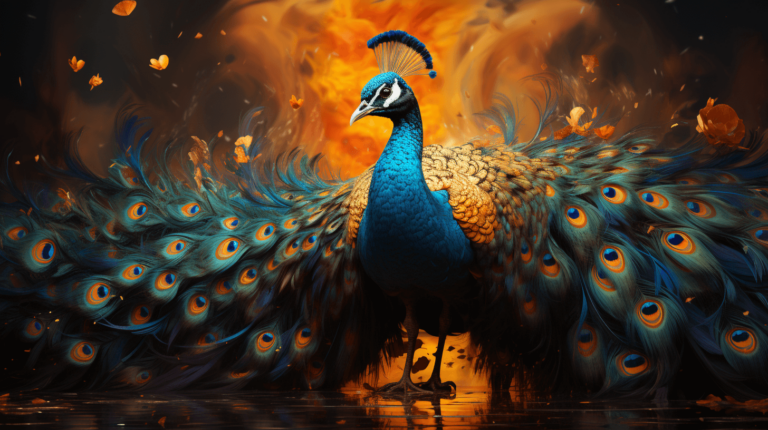Mysteries of Matter and Reality
Welcome to a journey through the mystical and profound realms of metaphysical philosophy. In this article, titled “Mysteries of Matter and Reality,” we embark on an exploratory voyage to understand some of the most intriguing and complex concepts that have fascinated thinkers and philosophers for centuries.
Our exploration is divided into three parts, each delving into different aspects of the universe and our existence within it. We start by examining the eternal nature of matter, understanding how it intertwines with the spirit and evolves through time. In the second part, we venture into the cosmic dynamics, revealing the process through which the universe transitions from an ideal state to the phenomenal world we experience. Finally, we conclude by reflecting on the illusory nature of our perceived reality and our role in the grand cosmic drama.
This article is designed to be accessible and engaging for students and readers who are new to these concepts. It presents a tapestry of ideas drawn from various traditions, including Hermeticism, Neoplatonism, and Eastern philosophies, inviting you to contemplate the deeper, more abstract aspects of our existence. So, let’s begin this enlightening journey to unravel the mysteries of matter and reality, and discover the intricate interplay between the material and the spiritual realms.
“The eye through which I see God is the same eye through which God sees me.” – Meister Eckhart
Part One:
Understanding the Nature and Evolution of Matter
Our journey begins with a fascinating concept: the nature of matter. Imagine matter as something that has always been around, never created, just existing eternally. It’s like the oldest story that never had a beginning. This idea aligns with ancient wisdom, particularly from figures like Hermes Trismegistus, a legendary thinker from the Hellenistic period who is often linked to the mystical and alchemical knowledge.
Interestingly, matter is not just a lifeless entity; it serves as a vehicle for spirit. This perspective paints a picture where the material world and the spiritual realm are deeply intertwined. It’s like the spirit is the driver, and matter is the car, together navigating the cosmos.
Now, let’s dive into the concept of ‘becoming.’ Matter isn’t static or unchanging. Instead, it’s always in the process of change, evolving and shaping itself into new forms. This is driven by what’s called ‘germs of becoming’ – potentials within matter that are brought to life by a creative force. It’s like having a hidden masterpiece within a block of marble, waiting to be revealed by a sculptor’s hands.
Adding to this, Dr. Anna Kingsford, a notable figure in esoteric philosophy, suggests that matter, before it starts ‘becoming,’ is in a passive state, like a sleeping giant holding immense potential energy. It’s when this energy is awakened that matter becomes dynamic, constantly progressing and evolving.
In exploring the nature of matter, we uncover a rich tapestry of ideas that extend far beyond the physical. Matter, often perceived as a static and inert substance, is revealed as a dynamic and eternal entity, continuously evolving and reshaping itself. This eternal existence and constant transformation of matter reflect a profound truth about our own nature and potential.
The intertwining of matter and spirit illustrates a fundamental unity in the cosmos, where the material world is not separate from the spiritual, but deeply connected and interactive. This unity mirrors our own lives, where the physical and spiritual aspects are in a constant interplay, each influencing and shaping the other.
The concept of ‘becoming’ in matter, driven by the ‘germs of becoming,’ suggests that within every aspect of the universe lies the potential for change and evolution. This idea resonates with our personal journey, where we too are always in a state of becoming, evolving from one form to another, constantly growing and adapting.
Matter’s initial passive state, described as a sleeping giant with immense potential energy, is particularly evocative. It symbolizes those moments in our lives when we might feel dormant or inactive, yet possess an untapped reservoir of potential and capability. The awakening of this potential in matter parallels our own awakening to personal growth and development.
This exploration of matter, therefore, is not just an academic exercise in understanding the physical world; it’s a metaphor for our own journey. It encourages us to recognize and harness the latent potential within us, to embrace the continuous process of change and growth, and to see ourselves as integral parts of a larger, ever-evolving universe. The nature of matter, thus, becomes a mirror reflecting our own nature – ever-present, ever-changing, and full of endless possibilities for transformation and growth.
In esoteric philosophy, the universe is seen in three distinct aspects:
- The EVER-EXISTING: This represents the eternal, unchangeable truth of the universe, something that is always there, unaffected by time or change.
- The PRE-EXISTING: Think of this as the blueprint of the universe, existing before anything takes a physical form. It’s like the initial idea of a building before it’s constructed.
- The PHENOMENAL: This is our perceived reality, the physical world that we interact with and experience through our senses.
This tripartite view helps us understand different states of reality, suggesting that what we see and experience is just one layer of a much more complex universe.
Exploring deeper into the mysteries of matter and reality, we encounter an intriguing concept: the ‘initial,’ ‘manifested,’ and ‘creative Triad.’ These elements represent different stages or aspects of the divine creation process:
- The ‘initial’ symbolizes the unmanifest potential, akin to a seed in its dormant state, full of future possibilities.
- The ‘manifested’ reflects the actualized reality, comparable to the sprouting and growth of the seed into a plant.
- The ‘creative Triad’ signifies the forces or principles that drive this transformation, similar to how sunlight, water, and nutrients nurture and develop the seed.
In essence, this exploration of the ‘initial,’ ‘manifested,’ and ‘creative Triad’ offers a profound allegory for the process of creation and transformation, both in the cosmos and within ourselves. It’s a reminder that everything in our universe, from the smallest seed to the vastest galaxy, undergoes a journey from potential to manifestation, guided by unseen forces. This journey is not just a cosmic phenomenon but a deeply personal one, reflecting our own path of growth and evolution. As we transition from dormant potential to our realized selves, we mirror the universe’s continuous cycle of creation and actualization, a testament to the intricate and beautiful design of existence.
Part Two:
The Cosmic Drama: From the Eternal to the Phenomenal
Imagine the universe as an ageless entity, existing beyond our conventional understanding of form and time. This is the EVER-EXISTING aspect, a realm of absolute reality, unchanging and eternal. It’s like the deep, unending ocean of existence, from which everything else emerges.
Before anything takes physical form, there exists a blueprint or an ideal plan of the universe – this is the PRE-EXISTING state. Think of it as a grand design or a master plan that hasn’t been brought to life yet. It’s the universe in its conceptual phase, full of possibilities and potentialities.
Then, we have the PHENOMENAL universe, the world as we know and perceive it through our senses. This is the universe in action, the physical manifestation of the ever-existing and pre-existing states. It’s like the stage where the script of the universe is played out, complete with its diverse cast of characters and events.
So, how does the phenomenal universe come into being from these other states? The answer lies in the evolution from the ideal plan, existing in the unconscious of absolute reality (akin to the Vedantic concept of “parabrahman“). This plan is eternal, much like Plato’s realm of forms, where self-existing ideas transcend everyday reality.
Let’s delve into the concept of absolute reality, often paralleled with the Vedantic concept of “parabrahman.”
In many philosophical and spiritual traditions, absolute reality is perceived as the ultimate, unchanging truth. This reality is beyond our physical universe and transcends all forms and phenomena that we experience through our senses. It’s akin to a vast, boundless ocean of existence, pure and undifferentiated. In this realm, there are no individual entities or separations; everything is part of a singular, all-encompassing oneness.
The Vedantic tradition of Hindu philosophy introduces us to “parabrahman,” a term that encapsulates this notion of absolute reality. Parabrahman is beyond description and beyond comprehension, existing beyond the realm of the material world and its limitations. It is not affected by time, space, or causation. In this state, there is no change, no birth or death, only eternal existence. It’s the ultimate source and ground of all being, from which everything emanates and to which everything eventually returns.
This concept is somewhat mirrored in Plato’s realm of forms, where ideal forms or ideas exist in a state of perfection. Plato envisioned a world of abstract forms that represent the truest, most fundamental reality. These forms are not physical but are the essence of all things that manifest in the physical world. They are eternal, unchanging, and exist beyond our sensory experience.
In summary, when we talk about the absolute reality or parabrahman, we’re referring to a state of existence that is beyond our normal understanding of the world. It’s a realm where the ultimate truths reside, untouched by the ebb and flow of material existence. Understanding this concept invites us to expand our perception of reality, acknowledging that there is much more to existence than what we experience in our daily lives. It’s a profound reminder of the endless depth and mystery that underlies the universe we inhabit.
Building on the profound understanding of absolute reality and parabrahman, let’s explore the mechanism behind the universe’s manifestation. The process is often described metaphorically as the “Great Breath,” signifying a divine or cosmic force that initiates each cycle of creation. Picture this as the initial spark or the first domino that sets in motion a series of cosmic events, birthing the universe as we know it.
Central to this cosmic unfolding are two opposing yet complementary forces: centripetal and centrifugal. These forces embody a fundamental duality within the cosmos. Like dancers in an intricate cosmic ballet, the centripetal force draws inward, while the centrifugal force pushes outward. They exist in a harmonious yet dynamic balance, described in various traditions as male and female, positive and negative, physical and spiritual. These forces are not just abstract concepts; they are the primary drivers that transition the universe from the realm of the eternal ideal to the realm of finite manifestation.
This dance of forces brings to life the concept that everything in existence, everything that has ever existed, or will come into being, is a reflection of eternal ideas. The physical forms that populate our universe, while perishable and ever-changing, are underpinned by an essence that is timeless. These forms are finite expressions of infinite ideas, embodying the transition from the abstract and ideal to the concrete and manifested.
In this exploration, we delve into the heart of metaphysical philosophy, uncovering how the unseen and eternal blueprint of reality takes shape in the physical world we experience. It’s a journey that bridges the gap between the known and the unknown, revealing the intricate tapestry of existence where the eternal and the transient, the ideal and the real, interweave to create the rich tapestry of the cosmos.
Part Three:
The Illusion of Reality and the Cycle of Cosmic Drama
As we delve deeper into the cosmic narrative, we encounter the concept of the ETERNAL IDEAL. This represents the inner, unmanifested reality, where eternal ideas or forms exist. It’s akin to a hidden dimension where the blueprint of all existence resides, untouched and pure.
In contrast, the PERPETUAL MOTION, symbolized by the ‘Great Breath,’ is the dynamic process that brings these eternal ideas into manifestation. This cosmic force or divine energy is what animates the universe, transforming the unmanifested into the manifested.
The finite manifestation, which is our cosmic or phenomenal plane, is the visible, physical reality we interact with. It emerges from the eternal ideas taking form through perpetual motion. The philosophy posits that every physical form, whether natural or human-made, has an ideal form or archetype in the eternal realm.
An intriguing aspect is the concept that nothing is entirely new; all forms are manifestations of pre-existing ideas. This process is described as moving from the most sublimated (pure) state to the most gross (material) form, much like an artist bringing a vision to life from the depths of imagination.
This brings us to the concept of illusion, or ‘Maya,’ in the phenomenal universe. Compared to the unchanging reality of the ‘one’ or the absolute, our world is transient and ever-changing, thus considered an illusion. This idea is central to Eastern philosophies, where the material world is seen as a temporary stage in a broader, unchanging reality.
Life, then, is likened to a cosmic play or drama, ‘Manvantara,’ where we see only the shadows of reality, much like puppets casting shadows behind a screen. The true form of the cosmos remains unseen, operated by unseen forces beyond our comprehension. We, as part of this universe, are also actors in this grand illusion.
While the universe might be an illusion, it is real enough for those within it. We are part of this grand illusion, living and experiencing it as our reality. This ties back to the idea that what we know and perceive is just one aspect of a much larger, more complex, and eternal structure of existence.
As we reach the culmination of our exploration into the illusion of reality and the cycle of cosmic drama, we are confronted with profound philosophical questions that challenge our understanding of existence and our role within it.
The Question of Free Will
The concept of free will is deeply intertwined with the notion of the cosmic drama we find ourselves in. Do we, as actors in this grand play, have the autonomy to choose our paths, or are we merely following a predetermined script? While the universe unfolds according to its own laws and rhythms, the idea of free will suggests that within this cosmic framework, we possess the capacity to make choices and influence the course of our lives. This autonomy is not absolute but operates within the boundaries of cosmic laws, much like an actor who improvises within the confines of the play’s theme.
The Infinite Play of Life
Why must this drama unfold infinitely? The endless cycle of creation, preservation, and destruction, a concept echoed in many philosophical and spiritual traditions, points towards a universe in constant evolution. This perpetual motion, symbolized by the ‘Great Breath,’ suggests that the universe is a dynamic, ever-changing entity, with each cycle offering opportunities for growth, learning, and experiencing new aspects of existence. The infinity of this process reflects the boundless nature of the universe itself, always moving, always evolving.
The End of the Cosmic Drama
Will this cosmic drama ever reach a conclusion? In many spiritual beliefs, the end of one cycle is merely the beginning of another. The notion of an ultimate end is replaced by the idea of transformation and renewal. This cyclical view of existence implies that while individual dramas may conclude, the overarching cosmic drama continues, eternally reinventing and expressing itself in myriad forms.
The Beauty and Purpose of Life
The question of life’s inherent beauty and purpose has been a subject of contemplation across various philosophical and esoteric traditions. Each offers a unique perspective on what it means to find beauty and purpose in existence.
In the realm of Platonism, beauty and goodness are seen as absolute concepts existing in the realm of forms. Our world, being a mere reflection of this realm, has the potential to mirror this beauty and goodness. This perspective encourages an exploration of these ideal forms, suggesting that the purpose of life lies in striving towards these higher, more perfect models of beauty and goodness.
Neoplatonism takes this a step further by positing The One as the ultimate source of all existence and inherently good. Our existence, as emanations from The One, is a journey back to this source, a process that is beautiful in its pursuit of returning to the original state of goodness and unity.
Hermeticism speaks of “The All,” encompassing everything that exists. It holds that “The All” is inherently good, and thus, life in all its forms is a manifestation of this goodness. In this view, the beauty and purpose of life lie in recognizing and aligning with the goodness that underpins all existence.
Stoicism teaches that living in accordance with nature and reason is the path to virtue and goodness. The beauty of life, in this view, is found in accepting the natural order and rational structure of the universe, and living a life that is in harmony with these principles.
Existentialism shifts the focus to individual existence. It argues that beauty and purpose are not predefined but are created through our choices and actions. In this philosophy, the purpose of life is to live authentically and create our own meaning, even in the absence of an absolute reality.
Eastern philosophies like Vedanta and Buddhism view the ultimate reality as beyond the dualistic concepts of good and bad. The beauty and purpose of life, from this perspective, are found in understanding and aligning with this ultimate reality, leading to a state of peace, harmony, and enlightenment.
These diverse philosophical perspectives offer a rich tapestry of insights into the beauty and purpose of life. They suggest that life’s beauty lies in its complexity, diversity, and our capacity to perceive, learn, and adapt. Whether it’s through aligning with ideal forms, returning to a source of goodness, living in harmony with nature and reason, creating personal meaning, or understanding a transcendent reality, each perspective provides a pathway to finding balance, harmony, and understanding in life.
In essence, these philosophies invite us to find beauty and goodness in our existence, to embrace the diversity of life experiences, and to seek a harmonious and purposeful path in our journey through the cosmos.
Reality, Meaning, and Our Role
In the face of life’s illusions and the grandeur of the cosmic play, one might wonder if anything truly matters or if our choices and actions have any real significance. This existential inquiry brings us back to the concept of Maya and the idea that while the phenomenal world may be transient, it is real in our experience. Our actions, choices, and experiences contribute to our growth and understanding. We are not just passive actors; we are co-creators of our reality, imbuing our lives with meaning through our perceptions, decisions, and interactions.
In conclusion, as we navigate the cosmic drama, we are invited to reflect on these philosophical questions, exploring the nature of free will, the purpose of the infinite play, the beauty of life, and our role in this grand scheme. While definitive answers may elude us, the journey of contemplation and understanding enriches our experience, offering a deeper appreciation of our existence within this vast, mysterious, and ever-evolving cosmos.
In our final synthesis of these ideas, let’s consider the journey of the Knight of Pentacles, a figure of steadfastness and dedication. Like this Knight, we are encouraged to approach life step by step, with patience and individual responsibility, recognizing that progress is often gradual and requires consistent effort.
As we align with the universal rhythm, the monad reminds us that the ultimate reality may be ineffable, yet through our experience and connection to the energy of the universe, we can engage in a dialogue with the unseen forces. This dialogue is not with the physical entities we can perceive but rather with the metaphysical principles that govern our existence.
By developing our own system, integrating intuition, and strong faith, we open ourselves to the flow of synchronicities that signal our attunement with the cosmic order. These systems should not be rigid but rather should remain open to adaptation and growth, informed by our continuous quest for understanding.
We find that as we cease to cling to any single dogmatic system and instead embrace a harmonious blend of wisdom, the magic of the cosmos unfolds before us, leading to a profound realization that everything is connected and every step we take is part of a larger, divine choreography.
This journey we undertake is not just about personal development but about recognizing our place within the cosmic play, contributing our unique verse to the eternal story. The path of the Knight of Pentacles, grounded and steady, assures us that our disciplined pursuit of growth and understanding is not only meaningful but also vital to the cosmic tapestry in which we find ourselves interwoven.
In essence, this is a call to action—a reminder that through patience, persistence, and openness to the universal energies, we can discover not just the magic in the world around us, but also the magic within ourselves.

